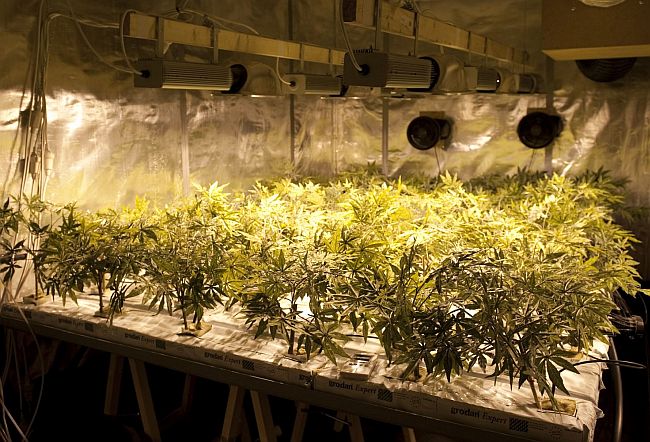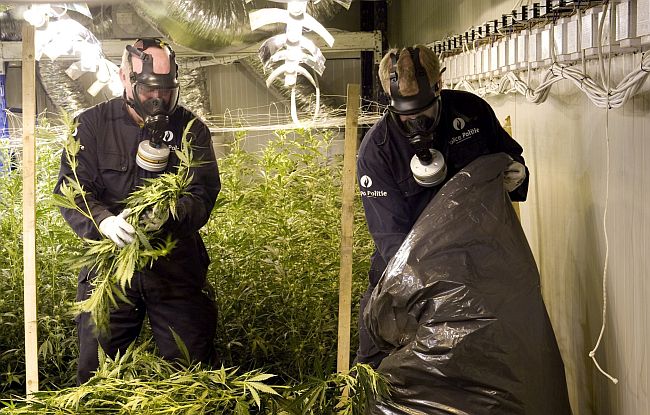
Radio amateurs and cannabis growers
Daylight is replaced by artificial light
Plants and flowers need light energy to grow through photosynthesis. Crops that are sensitive to temperature are grown in a greenhouse with natural sunlight. Artificial light can partially or completely replace sunlight, and can even be of a much better quality, on condition that certain lighting quality rules are observed.Until a few years ago, high-pressure grow lights were used for this purpose.
The power consumption of these lights was very high, they were expensive and they lasted barely 5,000 to a maximum of 10,000 hours before they failed. They were the first actual use of artificial light to stimulate growth of flowers and plants. Later on this method was cleverly applied for growing weed. To hide the massive power consumption, electricity was tapped before the electricity meter, all in all a risky business. The introduction of LED lighting significantly reduced power consumption and increased the lamps’ lifespan to values that are typically between 30,000 and 50,000 hours. As it happens, cannabis plants grow much better with specific LED grow lights or assimilation lighting than with sunlight. If it was previously possible to discover indoor plantations, this is now declining sharply with LED lighting.
And another phenomenon emerged. Radio amateurs with sophisticated antennas and equipment are being adversely affected in large numbers.

LED lighting and electromagnetic interference
Light is partly a wave. The speed of light in a vacuum environment is equal to the speed of the electromagnetic waves. Many LED grow lights disturb the electromagnetic waves. Not only the HF bands but also the aviation bands and VHF, both with analogue and digital equipment. Interference can occur with electromagnetic waves, either constructive interference when waves are in phase, or destructive interference when waves counteract, neutralising each other. Much of the LED lighting used in illegal plantations became a real source of interference. This kind of LED lighting usually does not meet the requirements with regard to EMC or Electromagnetic Compatibility.The explorers of the frequency spectrum
Radio amateurs are the true explorers of the frequency spectrum. Using sophisticated antenna systems and sensitive radio equipment, they try to capture as many electromagnetic signals as possible. By contrast, they try to reach other radio amateurs located as distant as possible with as little power (expressed in watts or milliwatts) as possible. All of this within the legal framework for reception and broadcast. The number of interferences is increasing. Even if the source of the interference is a little further away, they are affected, often caused by the assimilation lighting of the LED lights.The problem with EMC
In late May 2019, Ivanka Trump and Queen Maxima visited The Hague. Police officers encountered difficulties as they were exploring the area beforehand. Wireless connections were being seriously disturbed or had even become impossible. The investigation services revealed that the problem was caused by the inverters converting the direct current output of solar panels into alternating current on the commercial grid. Many inverters are not compatible with European EMC rules. The inverters were sending interference signals, with the wiring acting as an antenna.There was an adequate solution: the 252 solar panels in the area were switched off. A similar EMC problem occurs with the LED lighting in cannabis plantations.
Radio amateurs are not police officers
It goes without saying that radio amateurs are not detectives searching for cannabis growers. They only want to pursue a hobby activity. To do so, they invest money and they pay taxes to the government every year.If electromagnetic signals are disturbed, they have the right to file a complaint with the government. The appropriate government services will then try to locate the interference signals. Interferences first observed by radio amateurs are often accompanied by citizens’ complaints about problems with radio reception, remote controls or Wi-Fi. However, because of the high visibility of radio amateurs' antennas, they are often wrongly accused as the cause of the interference by ignorant citizens. Specialised investigation then usually leads to the discovery of all kinds of inexpensive unapproved electronic items, or to the discovery of cannabis plantations.
Ultimately, living in the vicinity of a radio amateur is not a bad idea. They are the first to discover any irregularities related to electromagnetic signals and they have every interest in this being resolved as quickly as possible.

Freddy De Schuiteneer -ON3FDS
Courtesy of VERON and the Federal Police
Photos and copyright: Federal Police, Lavinia Wouters and Freddy De Schuiteneer


